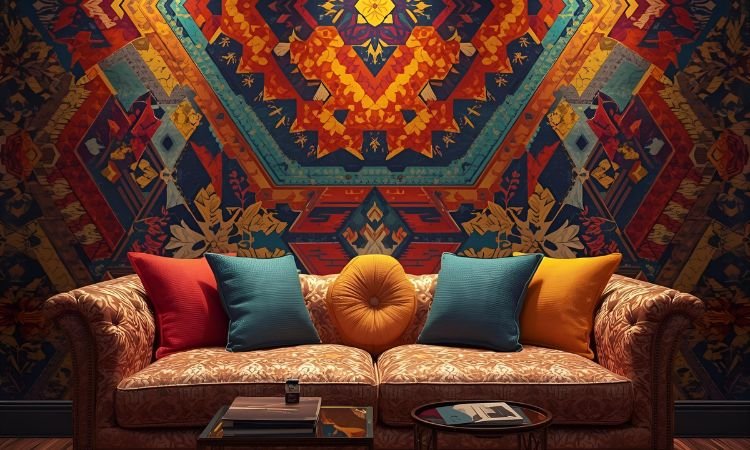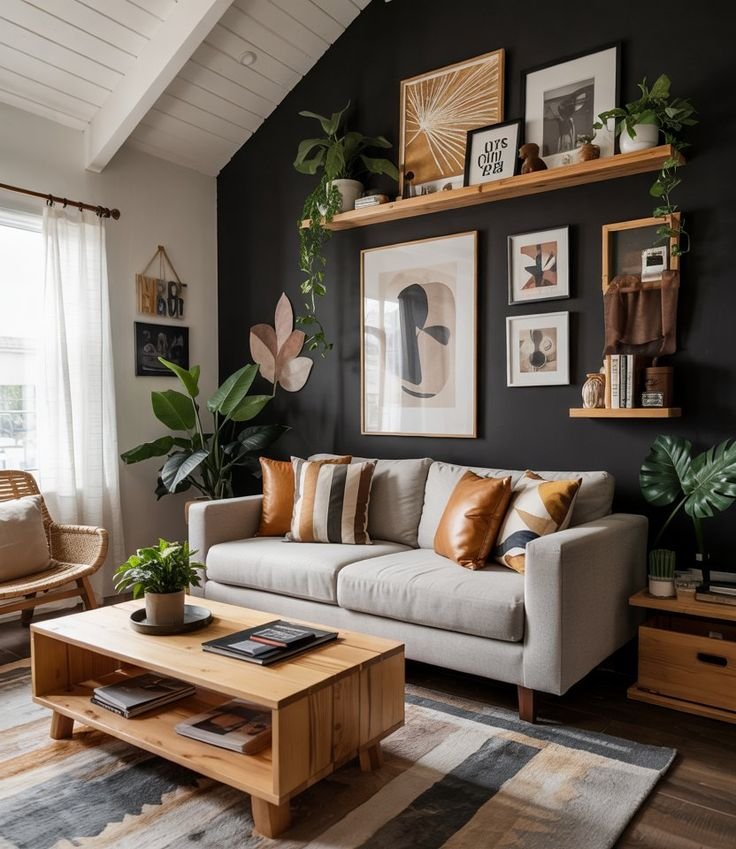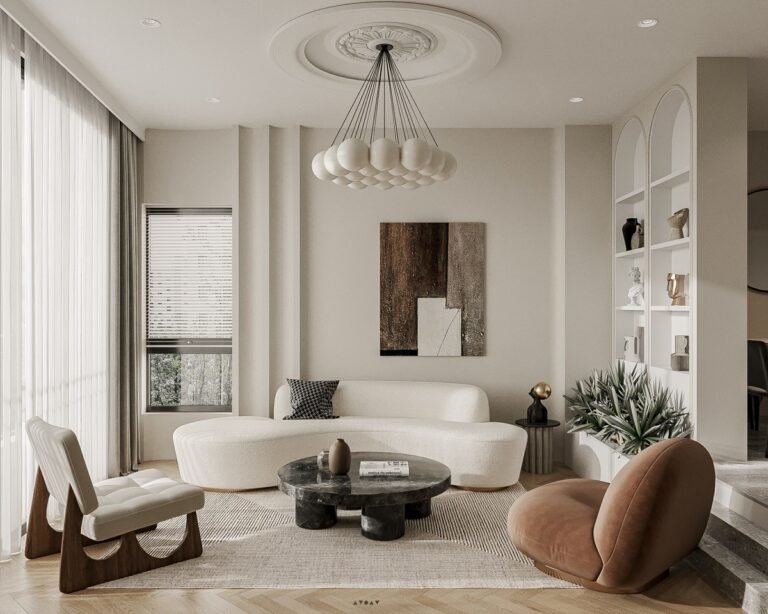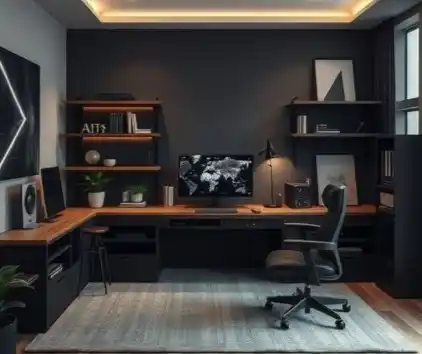
That wall behind your sofa is staring at you every time you walk into the room. You know it needs something, but what? Too much looks cluttered, too little feels unfinished, and everything you try just seems off. You’re not alone—this is literally the wall everyone struggles with.
The sofa back wall is tricky because it’s the main focal point in most living rooms. It’s what people see when they enter, it’s in every photo you take of your space, and it sets the tone for your whole room. Get it right and your living room feels complete. Get it wrong and everything else looks off too.
Here’s the thing—there’s no one-size-fits-all solution. What works depends on your sofa size, wall dimensions, ceiling height, and honestly just your personal style. That Pinterest-perfect gallery wall might look amazing in someone else’s space but feel totally wrong in yours.
Walking through 12 sofa back wall design ideas covering everything from classic art arrangements to architectural features. You’ll see what works for different wall sizes, how to avoid the most common mistakes people make, which approaches fit different decorating styles, and the actual measurements that make everything look balanced instead of awkward.
What Makes Sofa Wall Design Actually Work
- Proper Scale Prevents Awkwardness: Art or decor should be roughly two-thirds your sofa width, not smaller pieces floating above. It’s like wearing a belt where proportion to your body matters. The right scale creates visual connection between furniture and wall.
- Height Placement Affects Everything: Hanging art 6-8 inches above sofa back creates proper relationship, not randomly floating somewhere up the wall. It’s like hemlines where height completely changes the look. The positioning determines whether everything feels connected or disconnected.
- Balance Doesn’t Always Mean Symmetry: Even arrangements work but so do asymmetrical designs if done intentionally. It’s like interior design generally where balance matters more than matching. The visual weight on both sides should feel equal even if elements aren’t identical.
- Layering Adds Depth: Combining wall elements with furniture-top decor creates dimension flat walls can’t achieve alone. It’s like outfit styling where layers add interest. The depth prevents everything feeling stuck to the wall.
Sofa Back Wall Design Ideas
Transform your living room focal point with these sofa back wall designs that create polish and personality.
Large Single Artwork
Hang one substantial piece of art as your focal point. The single-piece approach feels clean and intentional while making strong statement. I’ve found this works especially well in modern or minimalist spaces where simplicity matters.
Choose artwork 48-72 inches wide for standard 84-inch sofa. Position bottom edge 6-8 inches above sofa back, centered horizontally. Canvas prints cost $150-500, original art runs $500-3,000+. Frame in simple black, natural wood, or leave frameless. This is honestly the easiest approach—buy one thing, hang it, done.
Symmetrical Diptych or Triptych
Display matching set of 2 or 3 panels creating cohesive horizontal arrangement. The connected pieces fill width while maintaining organized appearance. This works great for longer sofas where single piece would need to be massive.
For diptych, choose panels 30-36 inches wide each with 4-6 inches between. Triptych uses three 24-30 inch panels. Keep artwork consistent—same framing, complementary images, unified color palette. Total width should be 55-65 inches for standard sofa. Sets cost $200-800 depending on quality. The repetition creates impact without complexity.
Gallery Wall Grid
Arrange multiple framed pieces in organized grid pattern. The structured layout feels intentional rather than random collection. This approach lets you include different subjects or personal photos while maintaining cohesion through consistent framing.
Use 6-9 frames in same size and style creating 2×3 or 3×3 grid. Space 2-3 inches apart both horizontally and vertically. Start 6-8 inches above sofa mapping entire layout on floor first. Mix prints, photos, or art maintaining color palette. Budget $300-600 for frames and prints. The uniform spacing makes multiple pieces read as single installation.
Oversized Mirror Statement
Mount large mirror creating light-reflecting focal point. The mirror bounces natural light while making room feel larger. This works especially well in darker living rooms or small spaces needing visual expansion.
Choose mirror at least 48-60 inches wide in substantial frame. Window-style, sunburst, or simple rectangular frames all work depending on style. Position same as artwork—6-8 inches above sofa. Costs range $200-600 for quality pieces. Make sure mirror reflects something pleasant—windows, nice furniture, not awkward TV angles.
Floating Shelves with Layered Decor
Install 2-3 floating shelves displaying curated objects and leaning art. The dimensional approach adds depth beyond flat wall art. I mean, this lets you change things up seasonally without new nail holes everywhere.
Use shelves 48-60 inches long, 8-10 inches deep. Install 10-12 inches apart starting 8 inches above sofa. Layer framed art leaning against wall with plants, books, small sculptures. Shelves cost $40-100 each, decor varies. The flexibility here is huge—swap items refreshing look without commitment.
Accent Wall with Texture
Create architectural interest using wall treatment as focal point itself. The textured surface becomes backdrop making additional decor optional. This works when you want statement but aren’t art people or can’t commit to specific pieces.
Options include shiplap, board and batten, geometric wood panels, or textured wallpaper. Costs vary wildly—$200-1,000+ depending on material and DIY versus professional installation. Paint in complementary color or keep neutral letting texture create interest. Add simple wall sconces or single art piece if wall feels too plain.
Asymmetrical Art Grouping
Arrange different-sized pieces in intentional off-center layout. The varied scale and asymmetry creates modern dynamic feeling. This approach suits eclectic or contemporary spaces better than traditional rooms.
Start with largest piece slightly off-center, add smaller pieces balancing composition. Vary frame sizes and orientations—mix horizontal and vertical. Maintain consistent color palette or framing style preventing chaos. Map layout on floor first ensuring balance before hanging. Total arrangement should span 55-70 inches wide. Costs $250-700 depending on pieces chosen.
Built-In Shelving Surround
Install floor-to-ceiling shelving flanking sofa wall creating library wall effect. The architectural addition provides display space while framing sofa beautifully. Yeah, this is more involved but the impact is serious.
Use ready-made units like IKEA Billy bookcases ($70-150 each) flanking wall, or custom built-ins costing $1,500-4,000 professionally installed. Paint shelves matching walls or contrasting color. Style with books, objects, small art. Leave central wall section above sofa for single piece or mirror. This basically solves all your wall decor questions permanently.
Vertical Panel or Tapestry
Hang large textile, tapestry, or fabric panel adding softness and texture. The organic material warms up spaces feeling too hard or cold. This works great in bohemian, eclectic, or casual spaces wanting something different from standard art.
Choose woven wall hangings, macramé pieces, or textile art 40-60 inches wide. Natural fibers in neutral tones feel sophisticated while colorful patterns add personality. Costs range $80-400 for quality handmade pieces from Etsy or boutiques. The texture adds dimension prints can’t achieve.
Console Table with Layered Artwork
Place console table behind sofa creating surface for lamps and decor, with artwork hung above. The furniture addition solves two problems—table provides function while anchoring wall treatment. Sound familiar? Every designer does this setup.
Use console 60-70 inches long, 10-12 inches deep sitting flush against sofa back. Hang art 4-6 inches above console (12-14 inches above sofa). Add matching lamps, small plant, books, or objects on table surface. Console costs $150-500, art and accessories add $200-400. The layered approach creates depth and sophistication.
Plate Wall Collection
Display decorative plates in organized pattern creating unique focal point. The dimensional ceramics add texture and shadow interest. This works beautifully in dining-adjacent living rooms or eclectic traditional spaces.
Collect 7-12 plates in coordinating colors or patterns. Arrange in cluster or grid using plate hangers ($2-5 each). Mix sizes from 8-12 inch diameter. Space 2-4 inches apart. Total arrangement spans 48-60 inches wide. Thrift store plates cost $3-15 each making this potentially cheap ($50-200 total). The unexpected approach creates conversation piece.
Wall Paneling with Integrated Lighting
Install decorative wall paneling creating architectural backdrop with sconces flanking. The combined approach solves both lighting and decoration questions simultaneously. This feels really polished and custom without requiring art.
Add picture frame molding, board and batten, or modern slatted panels to wall. Install 2-3 feet beyond sofa edges creating defined zone. Costs $300-800 DIY, $1,000-2,500 professionally installed. Add matching sconces 60 inches apart, 65-70 inches from floor. The permanent architectural solution means you’re basically done decorating this wall forever.
Getting Your Sofa Wall Right
- Measure Everything First: Know your exact sofa width, wall dimensions, and ceiling height before buying anything. It’s like furniture shopping where measurements prevent expensive mistakes. The numbers determine what actually fits properly.
- Map Layout Before Hanging: Use painter’s tape outlining where art will go, or lay everything on floor in arrangement. It’s like trying on clothes where seeing it first prevents regrets. The preview ensures proper spacing and scale.
- Anchor with Console When Possible: Adding furniture between sofa and wall creates layered, designer-done appearance. It’s like accessorizing where additional elements complete the look. The furniture grounds wall treatment making everything feel intentional.
- Consider Ceiling Height: Standard 8-foot ceilings limit vertical space while 10+ foot ceilings need taller arrangements. It’s like clothing proportions where your frame affects what works. The available height determines whether vertical or horizontal emphasis works better.
Frequently Asked Questions About Sofa Back Wall Design
How Wide Should Art Be Compared to Sofa?
Aim for art or arrangement measuring 60-75% of sofa width. For standard 84-inch sofa, that’s 50-63 inches of wall coverage. Too narrow looks dinky and insignificant, too wide overwhelms sofa making it feel unbalanced.
If using multiple pieces, calculate total width of arrangement including spaces between frames. The complete grouping should hit that 60-75% range, not individual pieces.
What If You Have Low Ceilings?
Focus on horizontal arrangements rather than vertical to avoid emphasizing limited height. Choose wider pieces that emphasize room width instead. Hang art standard 6-8 inches above sofa—going higher eats precious vertical space making ceilings feel lower.
Skip tall narrow pieces that draw eyes to ceiling height. Use horizontal mirrors, landscape-oriented art, or wide shallow shelves maximizing what height you have.
Can You Put TV Above Sofa?
Not recommended—viewing angles are terrible and neck strain is real. TVs belong on opposite wall from main seating, not behind it. I know some people do this in weird layout situations, but it’s almost never the best solution.
If TV must go on that wall, position it to side on console rather than directly centered above sofa. Or mount TV on articulating arm pulling forward for better viewing angles. But really, rearrange furniture if possible.
What About Rental Restrictions?
Removable options work great—command strips hold surprisingly heavy frames, lean large pieces on console or floor, use tension rods for textiles, or invest in freestanding screens. The temporary solutions look just as good as permanent installations.
Floating shelves need anchoring but holes fill easily when moving. Gallery walls require multiple holes but spackle and paint fix that. Most landlords don’t care about reasonable nail holes from art hanging—it’s expected wear.
How Do You Light Artwork Properly?
Add picture lights mounted to frames, plug-in sconces flanking art, or track lighting from ceiling. The dedicated lighting makes artwork look expensive and intentional. Battery-operated picture lights cost $20-40, plug-in sconces run $50-150 per pair.
Position lights directing downward at 30-degree angle preventing glare. Warm LEDs look better than cool white. The proper lighting transforms mediocre art into statement pieces worth the wall space.
Completing Your Living Room
Sofa back wall design ideas show this challenging space becomes your living room’s best feature with right approach. The thoughtful combination of scale, height, and style creates that pulled-together look you see in magazines. And honestly, once you nail this wall, everything else in your room falls into place way easier.
Start by measuring your sofa and wall space accurately. Consider your ceiling height and existing furniture. Choose approach matching your commitment level—temporary renters need different solutions than permanent homeowners. The smart planning prevents expensive do-overs.
What’s your biggest sofa wall challenge—choosing what to hang, getting sizing right, or finding pieces you actually love? Tell me what you’re stuck on and I’ll help figure it out!






